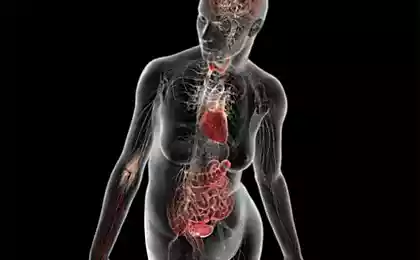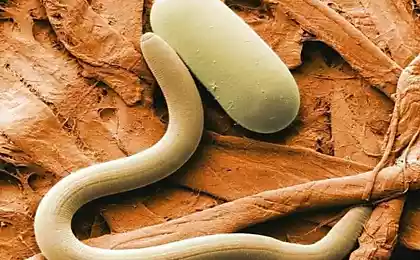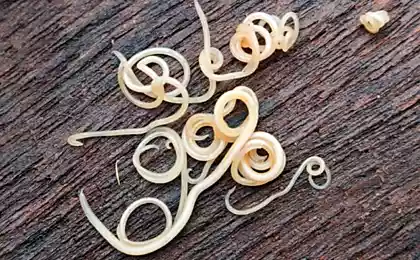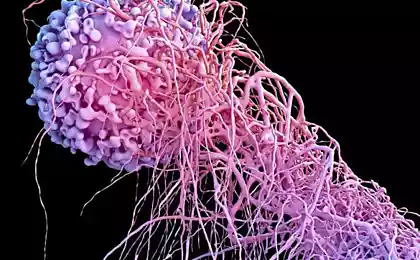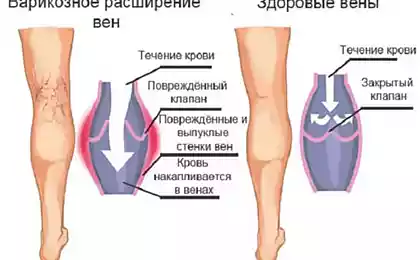449
How to get rid of worms
Ascariasis is a common parasitic infestation that is found among people of all ages. The causative agent of this disease is the roundworm Ascaris.
Ascaris is a large nematode of red color and vermiform shape, the length of which reaches 40 cm the Characteristic feature of this worm is curved caudal end of males. Infection of Ascaris occurs by ingestion of Mature eggs from unwashed vegetables, fruits, unboiled and untreated water. The reservoir of the nematode is often the soil is contaminated with feces of a sick person.

Once in the lumen of the small intestine, the eggs appear, the larvae embedded in mucosa and penetrate into the venous bed. Through the blood of larvae into the lungs, where it ends up in the delicate capillaries of the alveoli. Then migrate to the alveolar mucus, from bronchial secret fall into the mouth and re-swallow. Re-once in the intestine, they become Mature individual, which begins to self-multiply. On average, migration of ascarids through the body takes about 10 days. Mature individual Ascaris to become after 2-3 months and a day already can lay 200 thousand eggs. Already adult roundworm can parasitize not only in the small intestine, but "climb" into the duodenum.
The clinical picture of ascariasis
Symptoms of ascariasis can be expressed in different degree. Often manifestations of this helminthiasis develop as a result of neuro-reflex layers and irritation of the wall of Ascaris.
In children the clinical picture is more pronounced and may appear as nausea, poor appetite, frequent pain in the umbilical region in the form of colic. Along with this symptoms children become distracted, inattentive, lethargic, inactive, irritable, have trouble gaining weight and rapidly losing weight.
In adults often occurs with ascariasis are scarce and blurred clinical picture. In addition to violations of the gastrointestinal tract possible symptoms of migration of larvae to organs. Penetration of larvae through the thin walls of the alveoli in the lungs can lead to damage of the blood vessels manifested by hemoptysis, and may cause the development of focal pneumonia.
In severe cases the development of helminthic intestinal obstruction as the result of obstruction of the bowel lumen tangle of ascarids. In some cases, perforation of the parasite to the intestinal wall with the development of inflammation of the peritoneum – peritonitis. In contact with ascarids in the common bile duct may be in breach of the outflow of bile and development of obstructive jaundice.
The fluid secreted from the body of nematodes can cause allergic reactions such as hives and allergic dermatitis.
Diagnosis
The diagnosis of ascariasis is based on detection of Mature individuals in the stool or eggs of Ascaris by microscopy of faeces. In some cases informative is x-ray of the bowel, ultrasound of the liver and bile ducts. Also used serological method to detect antibodies to Ascaris.
Treatment ascariasis
Treatment ascariasis best to start with its prevention. Plays a big role in personal hygiene, the violation of which becomes a common cause of ascariasis, especially in children. The eggs of ascarids are killed at high temperature, so all the fruits and vegetables is to parboil, to boil water, and the dishes of the patient to handle high temperatures.
Source: kakmed.com/
Ascaris is a large nematode of red color and vermiform shape, the length of which reaches 40 cm the Characteristic feature of this worm is curved caudal end of males. Infection of Ascaris occurs by ingestion of Mature eggs from unwashed vegetables, fruits, unboiled and untreated water. The reservoir of the nematode is often the soil is contaminated with feces of a sick person.

Once in the lumen of the small intestine, the eggs appear, the larvae embedded in mucosa and penetrate into the venous bed. Through the blood of larvae into the lungs, where it ends up in the delicate capillaries of the alveoli. Then migrate to the alveolar mucus, from bronchial secret fall into the mouth and re-swallow. Re-once in the intestine, they become Mature individual, which begins to self-multiply. On average, migration of ascarids through the body takes about 10 days. Mature individual Ascaris to become after 2-3 months and a day already can lay 200 thousand eggs. Already adult roundworm can parasitize not only in the small intestine, but "climb" into the duodenum.
The clinical picture of ascariasis
Symptoms of ascariasis can be expressed in different degree. Often manifestations of this helminthiasis develop as a result of neuro-reflex layers and irritation of the wall of Ascaris.
In children the clinical picture is more pronounced and may appear as nausea, poor appetite, frequent pain in the umbilical region in the form of colic. Along with this symptoms children become distracted, inattentive, lethargic, inactive, irritable, have trouble gaining weight and rapidly losing weight.
In adults often occurs with ascariasis are scarce and blurred clinical picture. In addition to violations of the gastrointestinal tract possible symptoms of migration of larvae to organs. Penetration of larvae through the thin walls of the alveoli in the lungs can lead to damage of the blood vessels manifested by hemoptysis, and may cause the development of focal pneumonia.
In severe cases the development of helminthic intestinal obstruction as the result of obstruction of the bowel lumen tangle of ascarids. In some cases, perforation of the parasite to the intestinal wall with the development of inflammation of the peritoneum – peritonitis. In contact with ascarids in the common bile duct may be in breach of the outflow of bile and development of obstructive jaundice.
The fluid secreted from the body of nematodes can cause allergic reactions such as hives and allergic dermatitis.
Diagnosis
The diagnosis of ascariasis is based on detection of Mature individuals in the stool or eggs of Ascaris by microscopy of faeces. In some cases informative is x-ray of the bowel, ultrasound of the liver and bile ducts. Also used serological method to detect antibodies to Ascaris.
Treatment ascariasis
Treatment ascariasis best to start with its prevention. Plays a big role in personal hygiene, the violation of which becomes a common cause of ascariasis, especially in children. The eggs of ascarids are killed at high temperature, so all the fruits and vegetables is to parboil, to boil water, and the dishes of the patient to handle high temperatures.
Source: kakmed.com/
The mushrooms had settled on the plants through bacterial genes
Paleontologists dug up the rocky mini-egeas

